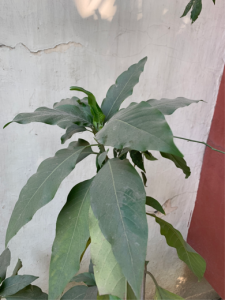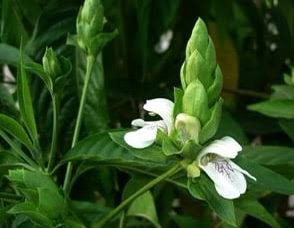BOTANICAL NAME: Adhathoda vasica Nees.
FAMILY: Acanthaceae
CLASSICAL CLASSIFICATION:
Charak- Tikta skanda
ENGLISH NAME: Malabar nut
COMMON NAME:
Hindi– Adosa, Rus
Punjabi – Vamsa, behkkar


REFERENCE: BHAVAPRAKASH SAMHITA with link e Nighantu:
https://niimh.nic.in/ebooks/e-Nighantu/bhavaprakashanighantu/?mod=read
HABITAT: All over India
BOTANICAL DESCRIPTION: Leaves are ensiform with many margins; Flowers are green, densely crowded on a cylindric, sessile spadix; Fruits are few seeded berries; Seeds are oblong. Flowering and fruiting during May to August.
AYURVEDIC CHARACTERISTICS:
| RASA | GUNA | VEERYA | VIPAKA | PRABHAVA | DOSHGHNTA |
| Tikta, kshaya | laghu rooksha | Sheeta | Kattu | kapha, pitta |
AYURVEDIC ENERGETICS
| TASTE | PROPERTY | POTENCY | POST DIGESTIVE EFFECT | EFFECT ACTION | DOSHA ACTION |
| Bitter, Astringent | Laghu, dryness | Cold | pungent | Pacifying kaphpitta |
MAJOR CHEMICAL CONSTITUENTS: Vasicine (peganine), Vasicinine, B- Sitosterol, Kaempferol, 3- Sophoroside, Luteolin, Tritriacontane, Adhatodic acid
THERAPEUTIC USES:
- Rheumatoid arthritis Its leaves are made into paste and applied to relieve pain.
- Laryngitis- 1 Teaspoon of juice of vasaka is administered along with 2 teaspoon of honey, twice a day.
INDICATIONS:
Jwara Pyrexia, Kustha Skin disorder, Chardi Vomiting, Kasa Cough, Swasha Asthma, Aruchi Anorexia
USEFUL PART: Whole plant
DOSAGE: Leaf Juice – 10-20 ml; Root decoction 40-80 ml; flower juice- 10-20 ml.
AYURVEDIC FORMULATION:
1. Decoction leaf powder
2. Vasa avelha
3. Vasa guduchyadi Kashaya
4. Vasa ghrit
